Varied difficulty levels in AP Inter 1st Year Zoology Model Papers and AP Inter 1st Year Zoology Question Paper May 2019 cater to students with diverse academic strengths and challenges.
AP Inter 1st Year Zoology Question Paper May 2019
Time: 3 Hours
Max. Marks: 60
Note: Read the following instructions carefully.
- Answer All the questions of Section A. Answer any SiX questions in Section B and answer any TWO questions in Section C.
- In Section A, questions from Si. No. 1 to 10 are of Very Short Answer Type. Each question carries two marks. Every answer may be limited to 5 lines. Answer all these questions at one place in the same order.
- In Section B, questions from Si. Nos. 11 to 18 are of Short Answer Type. Each question carries four marks. Every answer may be limited to 20 lines.
- In Section C, questions from SI. Nos. 19 to 21 are of Long Answer Type. Each question carries eight marks. Every answer may be limited to 60 lines.
- Draw labelled diagrams wherever necessary in Sections B and C.
Section – A
10 × 2 = 20
Note: Answer All questions in 5 lines each.
Question 1.
What does ICZN stand for?
Answer:
ICZN stands for International Code of Zoological Nomenclature which specifies the mandatory rules to be followed for the naming animals by International Congress (ICZ) in 1898.
Question 2.
What is monoaxial heteropolar symmetry? Name the group of animals in which it is the principal symmetry.
Answer:
Monaxial heteropolar symmetry: When any plane passing through the central axis of the body divides an organism into Two identical parts is called Monaxial heteropolar symmetry or radial symmetry, It is the principal symmetry of the diploblastic animals such as Cnidarians and ctenophores.
Question 3.
Distinguish between Brown fat and White fat.
Answer:
White fat: It is the predominant type in the adults, the adipocyte has a single large lipid droplet. White fat is metabolically not active.
Brown fat: It is found in foetus and infants. Adipocyte on Brown fat has several small ‘lipid droplets’ and metabolically act; and generates heat to maintain body temperature required by infants.
![]()
Question 4.
What are microglia and what is their origin? Add a note on their function.
Answer:
Microglial cells are the Neurogila (supporting cells) of cells of CNS which are phagocytic cells, of mesodermal origin.
Question 5.
What is the function of radula? Give the name of the group of Molluscs which do not possess a radula.
Answer:
The buccal cavity contains a file-like rasping organ called radula for feeding, excépt the bivalves and tusk of Molluscs.
Question 6.
What are Pneumatic bones? How do they help birds?
Answer:
Main bones in birds are extensions of air sacs without bone narrow are called pneumatic bones. These are helpful in flying to birds.
Question 7.
What is Kinety?
Answer:
In the ciliate protozoans, a longitudinal row of kinetosomes together with kinetodesmata constitute a unit called kinety.
Question 8.
Draw a labelled diagram of T.S. of flagellum.
Answer:
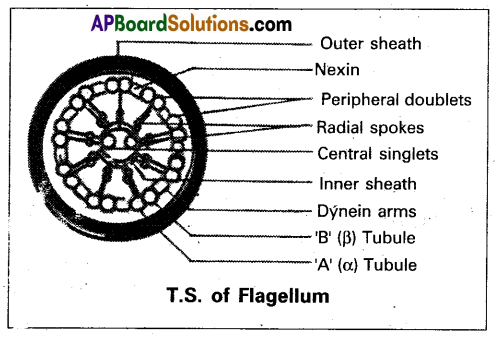
Question 9.
Define neoplasia. Give one example.
Answer:
Some causes an abnormal growth of the host cells in a tissue to form new structures. This effect is called Neoplasia which leads to cancers. Ex: Some Viruses.
Question 10.
What is camouflage? Give its significance.
Answer:
Some species of insects and frogs are cryptically coloured to avoid being detected easily by the predator. This phenomenon is called ‘‘Camuflage’’.
Section – B
6 x 4 = 24
Note: Answer any SIX questions in 20 lines each:
Question 11.
What are the reasons for greater biodiversity in the tropics?
Answer:
Reasons for greater biodiversity in the tropics:
Reason 1: Tropical latitudes have remained relatively undisturbed for millions of years and thus had a long ‘evolutionary time’. As long duration was available in this region for speciation, it led to the species diversification. (Note: The temperate regions were subjected to frequent glaciations in the past).
Reason 2: Tropical climates are relatively more constant and predictable than that of the temperate regions. Constant environment promotes niche specialization (how an organism responds, behaves with environment and with other organisms of its biotic community) and this leads to greater species diversity.
Reason 3: Solar energy, resources like water etc., are available in abundance in this region. They contribute to higher productivity in terms of food production, leading to greater diversity.
![]()
Question 12.
Describe the structure of skeletal muscle.
Answer:
Skeletal (striped and voluntary) muscle:
It is usually attached to skeletal structures by ‘tendons’. In a typical muscle such as the ‘biceps’ muscle, skeletal muscle fibre is surrounded by a thin connective tissue sheath, the endomysium. A bundle of muscle fibres is called a fascicle. It is surrounded by a connective tissue sheath called perimysium. A group of fascicles form a ‘muscle’ which surrounded by
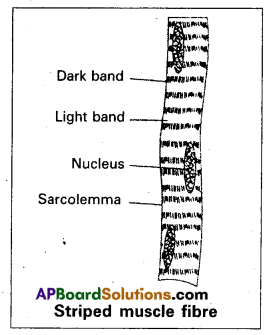
an epimysium (outermost connective tissue sheath). These connective tissue layers may extend beyond the muscle to form a chord-like tendon or sheet-like aponeurosis.
A skeletal muscle fibre is a long, cylindrical and unbranched cell. It is a multinucleated cell with many oval nuclei characteristically in the peripheral’ cytoplasm (a syncytium formed by fusion of cells). Sarcoplasm has many myofibrils which show alternate dark and light bands. So it is called striped or striated muscle.
Question 13.
Mention the general characters of Arachnida.
Answer:
- This includes scorpions, spiders, ticks and mites.
- Primarily they are all terrestrial.
- Prosoma bears one pair of preoral chelicerae, one pair of post-oral pedipalps and four pairs of walking legs.
- In spiders each chelicera bears a fang into which poison gland opens.
- Abdominal appendages are modified into book lungs, spinnerets, pectines etc.
- Telsun is usually absent. It is present as a sting in scorpions.
- Respiration is by the lungs or tracheae.
- Excretory organs are coxial glands and malpigh Ian tubules.
- Scorpions are viviparous.
- Development is direct. Ex : Palarnnaeus (scorpion) ; Aranea (spider).
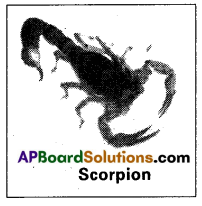
Question 14.
Write eight salient features of the class Amphibia.
Answer:
General characters of Amphibia:
- They are the first tetrapods and lead a dual mode of life, i.e. on land and in freshwater.
- Body is divided into distinct head and trunk. Tail may or may not be present.
- Skin is soft, scale-less (except the members of Apoda), moist and glandular.
- The body bears two pairs of equal or unequal pentadactyle limbs (caecilians are limbless).
- Skull is dicondylic as in mammals. Vertebrae are mostly precocious (centrum is concave at its anterior face only) in the anurans, amphicoelous in the caecilians and usually opisthocoelous (centrum is concave at its posterior face) in the urodeles. Sternum appeared for the first time in the amphibians.
- Mouth is large; teeth are acrodont, homodont arid polyphyodont.
- Respiratory gaseous exchange is mostly cutaneous; pulmonary and buccopharyngeal respiration also occur. Branchial respiration is performed by larvae and some adult urodeles.
- Heart is three-chambered with sinus venous and conus arteriosus. Three pairs of aortic arches and well-developed portal systems are present; erythrocytes are nucleated.
- Kidneys are mesonephric; and ureotelic.
- Meninges are the inner pia mater and outer dura mater; cranial nerves are 10 pairs.
- Middle ear consists of a single ear ossicle, the columella auris which is the modified ‘human- dibula’ of the fishes. Tympanum, lacrimal and harder plan glañds appeared for the first time in the amphibians.
- Sexes are separate and fertilization is mostly external, Development is mostly indirect. e.g. Bufo (toad), Rana (frog), Hyla (tree frog), Salamandra (salamander), Ichthyophis (limbless amphibian), Rhacophorus (flying frog).

Question 15.
Describe the process of transverse binary fission in Paramecium.
Answer:
Transverse binary fission is performed by Paramecium. Binary fission is the most common method of a sexual reproduction in protozoans.
During favourable conditions, Paramecium stops feeding after attaining its maximum growth. At first, the micronucleus divides by mitosis and the macronucleus divides into two daughter nuclei by amitosis. The oral groove disappears. After karyokinesis, a transverse constriction appears in the middle of the body, which deepens and
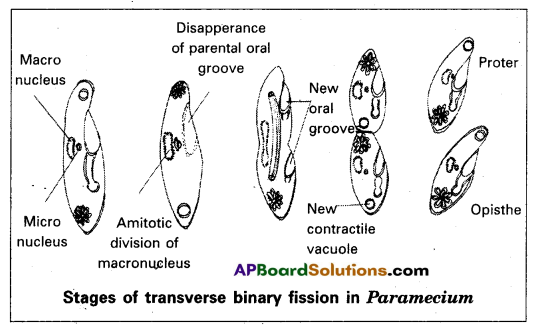
divides the parent cell into two daughter individuals, the anterior proter and the posterior opisthe. The proper receives the anterior contractile vacuole, cytopharynx and cytostome from its parent individual. It develops posterior contractile vacuole and a new oral groove. The opisthe receives the posterior contractile vacuole of its parent. It develops a new anterior contractile vacuole, cytopharynx, cytostome and a new oral groove. Binary fission is completed in almost two hours, in favourable conditions and Paramecium can produce four generations of daughter individuals by binary fission in a day.
The transverse binary fission is also called homothetogenic fission because the plane of fission is at right angles to the longitudinal axis of the body. As it occurs at right angles to the kineties, it is also called perkinetal fission.
Question 16.
What are the adverse effects of tobacco?
Answer:
Effect: Smoking increases the carbon monoxide (CO) level and reduces the oxygen level in the blood. Nicotine stimulates the adrenal gland to release adrenaline and nor-adrenaline into blood. These hormones raise the blood pressure and increase the heart rate.
Smoking is associated with bronchitis, emphysema, coronary heart disease, gastric ulcers and increases the incidence of cancers of throat, lungs, urinary bladder etc. Smoking also paves the way to hard drugs.
Yet smoking is very prevalent in society, both among young and old. Tobacco chewing is associated with increased risk of cancer of the oral cavity.
![]()
Question 17.
Draw a neat labelled diagram of the salivary apparatus of Cockroach.
Answer:
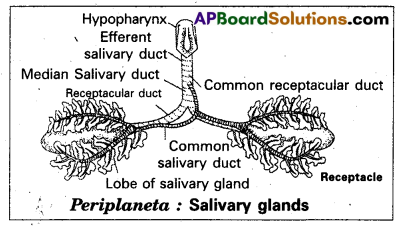
Question 18.
Explain Vant Hoff rule.
Answer:
Vant Hoff, a Nobel Laureate in thermo chemistry proposed that, with the increase of every 10°C, the rate of metabolic activities doubles. This rule is referred to as the Vant Hoff’s rule. Van’t Hoff s rule can also be stated in reverse saying that the reaction rate is halved with the decrease of every 10°C. The effect of temperature on the rate reaction is expressed in terms of temperature coefficient of Q10 value.
Q10 values are estimated taking the ratio between the rate of a reaction at X°C and rate of reaction at (X – 10°C). n the living systems the Q10 value is about 2.0. lithe Q10 value is 2.0, it means, for every 10°C increase,.
the rate of metabolism doubles.
Section – C
2 x 8 = 16
Note: Answer any TWO questions in 60 lines each.
Question 19.
Describe the structure and life cycle of Ascaris lumbricoides with the help of a neat and labelled diagram.
Answer:
Ascaris lumbricoicles is commonly called the common roundworm. It lives in the small intestine of man, more frequently in children. It is cosmpolitan in distribution. Mode of infection is through contaminated food and water. Infective stage is the embryonated egg with the 2nd stage rhabditi form larva.
Structure: Sexes are separate and the sexual dimorphism is distinct. In both males and females the body is elongated and cylindrical. Mouth is present at the extreme anterior end and is surrounded by three chitinous lips close to the mouth. Mid ventrally there is a small aperture called excretory pore.
Male: It has a curved posterior end which is considered the tail. The posterior end possesses a cloacal aperture and a pair of equal sized chitinous pineal spicules or pineal setae which serve to transfer the sperns during copulation.
Female: It has a straight posterior end, the tail. The female genital pore or vulva is present mid-ventrally at about one-third the length from mouth. The anus is present a little in front of the tail end.
Life history: Copulation takes place in the small intestine of man. After copulation, the female releases approximately two lakh eggs per day. Each egg is surrounded by a protein coat with rippled surface. Hence the eggs of Ascaris are described as mammillated eggs.
The protein coat is followed by a chitinous shell and a lipid layer internally. These eggs come out along with faecal matter. In the moist soil, development takes place inside the egg so that the 1st stage rhabditiform larva is produced. It undergoes the 1st moulting and
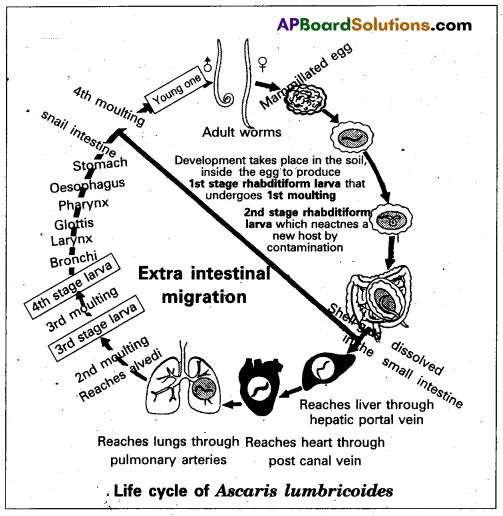
In the small intestine, the shell gets dissolved so that the 2nd stage larva is released. Now it undergoes extra intestinal migration. First, it reaches the liver through the hepatic portal vein. From there it reaches the heart through the post cavai vein. It goes to the lungs through the pulmonary arteries. In the alveoli of lungs it undergoes the 2nd’ moulting to produce the 3rd stage larva.

It undergoes the 3rd moulting so that the 4th stage larva is produced in the alveoli only. It leaves the alveoli and reaches the small intestine again through bronchi, trachea, larynx, glottis, pharynx, oesophagus and stomach. In the small intestine. It undergoes the 4th and final moulting to become a young one which attains sexual maturity within 8 to 10 weeks.

![]()
Question 20.
The blood circulatory system of Periplanata is of open type. Illustrate the statement describing the course of circulation in it.
Answer:
The blood flows forward in the heart by the contractions of its chambers. At the anterior end of the heart, the blood flows into the aorta and from there it enters the sinus of the head. From the head sinus, the blood flows into the perivisceral and sternal sinuses. On contraction of the alary muscles the pericardial septum is pulled down.
This increases the volume of the pericardial sinus. Hence blood flows from the pericardial septum. On relaxation of the alary muscles, the pericardial septum moves upwards to.its original position. This forces the blood, to enter the chambers of the heart through the ostia from the pericardial sinus.
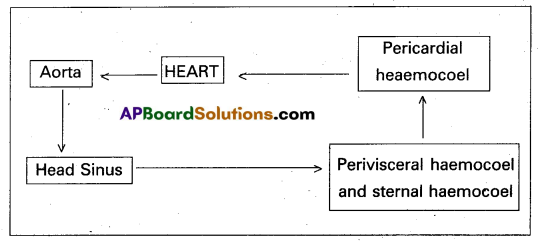
Question 21.
Describe lake as an ecosystem giving examples of the various zones and the biotic components in it.
Answer:
Deepwater lakes contain three distinct zones namely:
- Littoral zone
- limnetic zone and
- profulidal zone.
Littoral Zone: It is the shallow part of the lake closer to the shore. Light penetrates up to the bottom. It is euphotic (having good light) has rich vegetation and higher rate of photosynthesis, hence rich In oxygen.
Limnetic Zone: It is the open water zone away from the shore. It extends up to the effective light penetration level, vertically. The imaginary line that separates the limnetic zone from the profundal zone is known as zone of compensation/compensation point light compensation level. It is the zone of effective light penetration. Here the rate of photosynthesis is equal to the rate of respiration. Limnetic zone has no contact with the bottom of the lake.
Profundal Zone: It is the deep water area present below the limnetic zone and beyond the depth of effective light penetration. Light is absent. Photosynthetic organisms are absent and so the water is poor in oxygen content. It includes mostly the anaerobic organisms which feed on detritus.
The organisms living in lentic habitats are classified into pedantic forms, which live at the bottom of the lake and those living in the open waters of lakes, away from the shore vegetation are known as limnetic forms.
Biota (animal and plant life of a particular region) of the littoral zone: littoral zone is rich with pedantic flora (especially up to the depth of the effective light penetration). At the shore proper emergent vegetation is abundant with firmly fixed roots in the bottom of the lake and shoots and leaves are. exposed above the level of water.
These are amphibious plants. Certain emergent rooted plants of littoral zone are the cattails (Typha), bulrushes (scirpus) arrow heads (sagittana),. Slightly deeper are the rooted plants with floating leaves, such as the water lilies (Nymphaea), Nelumbo, Trapa, etc., still deeper are the submerged plants such as Hydrilla – Chara, Potamogeton, etc….
The free-floating vegetation includes pistia, Wolffia, Lemna (duckweed), Azolla, Eichhornia etc. The phytoplankton of the littoral zone composed of diatoms (CoscinodisCus, Nitzschia, etc) green algae (Volvox, spirogyra etc), euglenoids (Eu glena, photos, etc) and dinoflagellates (Gym neodymium, Cystodrnium, etc ….)
Animals, the consumers of the littoral zone, are abundant in this zone of the lake, these are categorized into zooplankton, neuston, nekton, periphyton, and benthos The Zoo-plankton of the littoral zone consist of water fleas such as Daphnia, rotifers and ostracods.
The animals living at the air-water interface constitute the neuston. They are of two types. The epineuston and hyponeuston. Water striders (Gerris), beetles, water bugs (Dineutes) form the epineuston/supraneuston and the hyponeuston/infraneuston includes the larvae of mosquitoes.
The animals such as fishes, amphibians, water-snakes, terrapins, insects like water scorpions (Ranatra), back swimmers (Notonecta), driving beetles (Dytiscus), capable of swimming constitute the nekton.
The animals that are attached to / creeping on the aquatic plants, such as the ‘water snails’, nymphs of insects, bryozoans, turbellarians, hydras etc, constitute the periphyton.
The animals that rest on or move on the bottom of the lake constitute the ‘benthos’, e.g.: red annelïds, chironomid larvae, cray fishes, some iso pods amphi pods, clams etc.
Biota of the limnetic zone: Limnetic zone is the largest zone of a lake. It is the region of rapid variations of the level of the water, temperature, oxygen availability etc., from time to time. The limnetic zone has autotrophs (photosýnthetic plants) in abundance. The chief autotrophs of this region are the phytoplankton suçh as the euglenoids, diatoms, cyanobacteria, dinoflagellates and green algae.
The consumers of the limnetic zone are the zooplanktonic organisms such as the copepods, Fisher frogs, water snakes etc., form the limnetic nekton.
Biota of the profundal zone: It includes the organisms such as decomposers (bacteria), chironomid larvae, Chaoborus (phantom larva), red annelids, clams etc., that are capable of living in low oxygen levels. The decomposers of this zoñe decompose the dead plants and animals and release nutrients which are used by the biotic communities of both littoral and limnetic zones.
The lake ecosystem performs all the functions of any ecosystem and of the biosphere as a whole. i.e., conversion of inorganic substances into organic material, with the help of the radiant softer energy by the autotrophs, consumption of the autotrophs by the heterotrophs; decomposition and mineralization of the dead matter to release them back for reuse by the autotrophs (recycling of minerals).